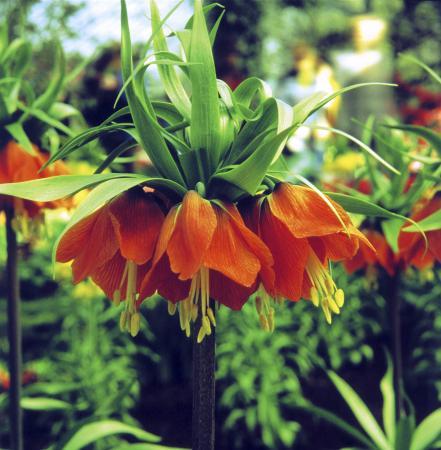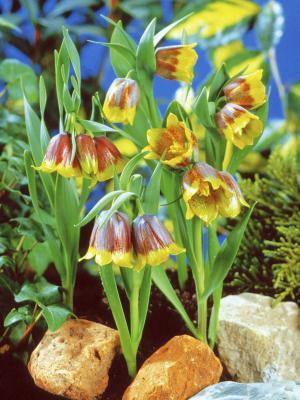By Carol Cowan
 | |
| This close up of Fritillaria imperialis rubra maxima shows a crown of blossoms at the top of a tall stem. |
These striking flowers have been around for ages (even appearing in 13th century artwork), yet the more adventurous Canadian residential, commercial and parks department landscape designers are now just discovering them. Fritillaries are a delightful addition to the garden, especially for those discerning, 'been there, done that' clients.
There are about 100 species of Fritillaria, but only four are easily available in the Canadian marketplace. All four are late spring bloomers, and they couldn't be more different from each other if they tried.
Fritillaria imperialis
Common name: Crown imperial
This is the most spectacular Fritillaria. Growing to a height of about 1 m, 8 to 12 large and dazzling yellow or red/orange flowers hang like bells at the top of the stem, which is topped by a pineapple-like tuft of leaves. The plant's lily-like leaves yellow and drop off after the flower has faded, so these beauties are best inter-planted with perennials that will hide this process.
One of the more striking features of both the bulb and the plant is a slight, funky, skunk-like aroma. As such, Fritillaria imperialis is ideal for beds, borders and island plantings (Toronto's Mount Pleasant Cemetery uses them to outstanding effect in island plantings), but it's not a good idea to plant them next to decks or seating areas in the garden.
Growing requirements
- Plant bulbs soon after purchasing, as they are susceptible to drying out.
In fall, plant fritillaries deeply, 25 to 45 cm to base of bulb. The fist-sized bulb has a deep hole in the centre from which the stem sprouts in the spring. As this hole can become waterlogged and damage the bulb, tip the bulb slightly on its side when planting. - The roots grow surprisingly deeply, so ensure that the soil below the bulbs is coarse and well drained.
- Plant in sunny to slightly shady locations. Water generously while growing, then cut back on the water.
- Mix in some granular fertilizer or bulb booster around the base of the plants, right after they emerge and again after they finish flowering.
|
Fritillaria Meleagris Common names: checkered fritillary, snake's-head lily, guinea-hen fritillary Growing to a height of between 25 and 35 cm, the flowers of F. Meleagris are enchanting, large pendent bells with square shoulders. Ranging in colour from white or cream to pink, mauve or dark purple, there is a lighter coloured checkered pattern on all. This species prefers moist, well-drained soil and full sun to partial shade. If left undisturbed, it will self-seed and naturalize. Its flowers become more abundant in its second and subsequent years of flowering. F. Meleagris grows well at the front of mixed flower borders, in mixed perennial beds, in rock gardens and under deciduous trees and shrubs.
Fritillaria michailovskyi This unusual fritillary is not difficult to grow, but is slow to increase. Plant in groupings of three to five, about 15 cm deep.
Fritillaria persica Plant deeply (25 to 35 cm), as this species does not tolerate late spring frosts. It prefers well-drained soil, which shouldn't dry out during its summer dormant period. Place in a relatively sheltered spot so that they won't be blown over by over-zealous gusts of wind. F. persica is a good choice for sunny perennial flowerbeds or borders. It also looks terrific planted among medium-height perennials or in front of larger shrubs. Fritillaries dislike upheaval in the garden, so, don't disturb the bulbs, or the area around them until they are well established (often two or more seasons). Most annual flowerbeds experience too much activity for fritillaries. Choose a location that is stable and relatively unchanging.
Final words |

